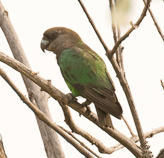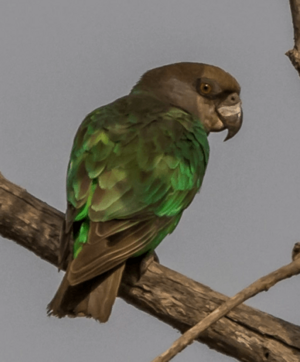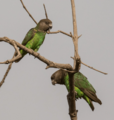Niam-Niam parrot facts for kids
Quick facts for kids Niam-Niam parrot |
|
|---|---|
 |
|
| A Niam-Niam Parrot in its natural habitat. | |
| Conservation status | |
| Scientific classification | |
| Genus: |
Poicephalus
|
| Species: |
crassus
|
The Niam-Niam parrot (Poicephalus crassus) is a special type of parrot. It mostly lives in the Central African Republic. This parrot is mostly green. It has a grey-brown head and bright orange eyes. The Niam-Niam parrot is one of the least known parrots in the world. For a long time, nobody had even taken a picture of it! The first photos were taken only in 2017.
Contents
What Does the Niam-Niam Parrot Look Like?
It is hard to tell the difference between male and female Niam-Niam Parrots. They look very similar. This bird has a grey-brown head and chest. Its belly and upper parts are green. The feathers under its wings are also green. It has a pale lower beak and bright orange eyes.
Unlike some other parrots in the Poicephalus family, the Niam-Niam Parrot does not have yellow feathers under its wings.
Where Do Niam-Niam Parrots Live?
The Niam-Niam Parrot lives in a large area of northern-central western Africa. This includes parts of eastern Cameroon and southwestern Chad. It also lives across the Central African Republic. You can find them in the very northern part of the Democratic Republic of Congo. They also live in the southwestern edge of Sudan.
We do not know exactly how many of these parrots there are. We also do not know their exact living areas. However, experts believe they are not in danger. This is because they live across a very large area.
Most Niam-Niam Parrots live in the Central African Republic. They enjoy living in both open grasslands (savannahs) and thick, diverse forests. These parrots usually live in trees. They rest and build their nests high up in the branches.
How Long Do Niam-Niam Parrots Live?
We do not know the exact lifespan of a Niam-Niam Parrot in the wild. But we can look at other parrots that are related to them. For example, the Senegal parrot and Meyer's parrot are similar. These parrots usually live for 20 to 30 years in the wild. If they live with people, they can live for 50 years or even longer!
What Do Niam-Niam Parrots Eat?
Poicephalus parrots eat many different kinds of food. They eat seeds, fruits, and leaves from various trees and bushes. They also enjoy nectar from flowers. Sometimes, they eat insects. Farmers have seen them eating maize (corn) and millet from crops. Because they sometimes eat crops, farmers might see them as a challenge to their harvests.
Images for kids






